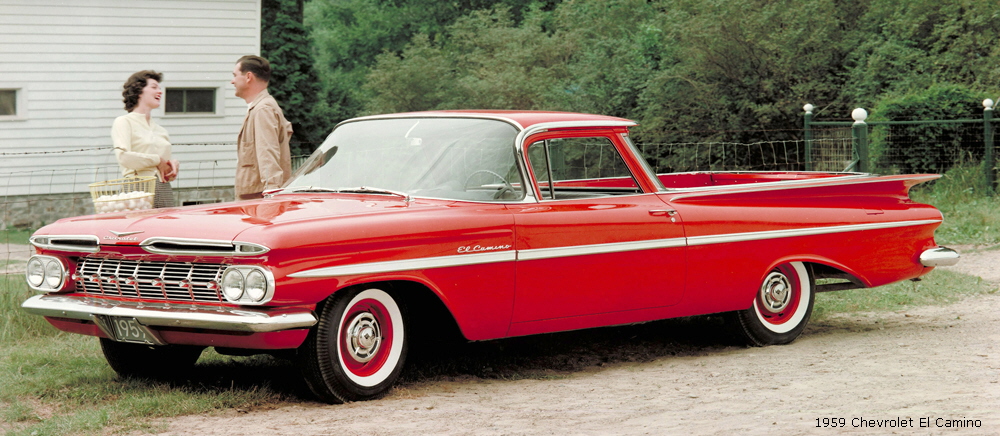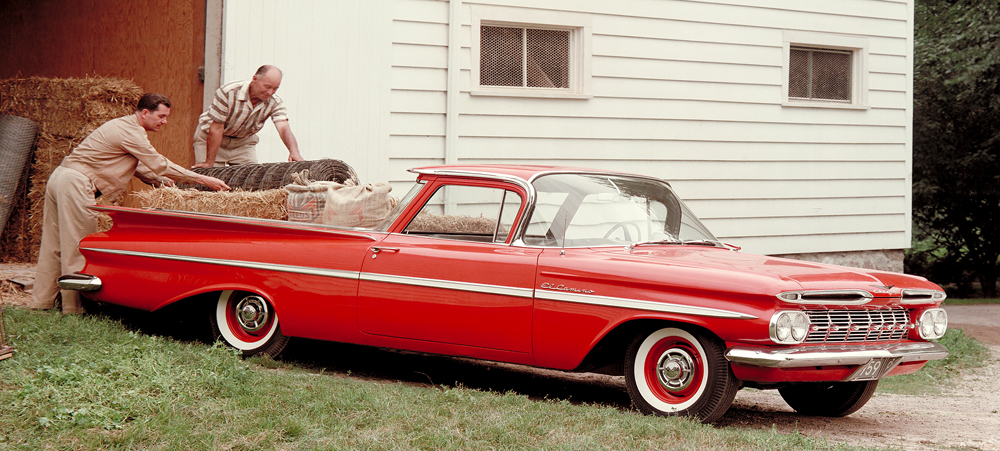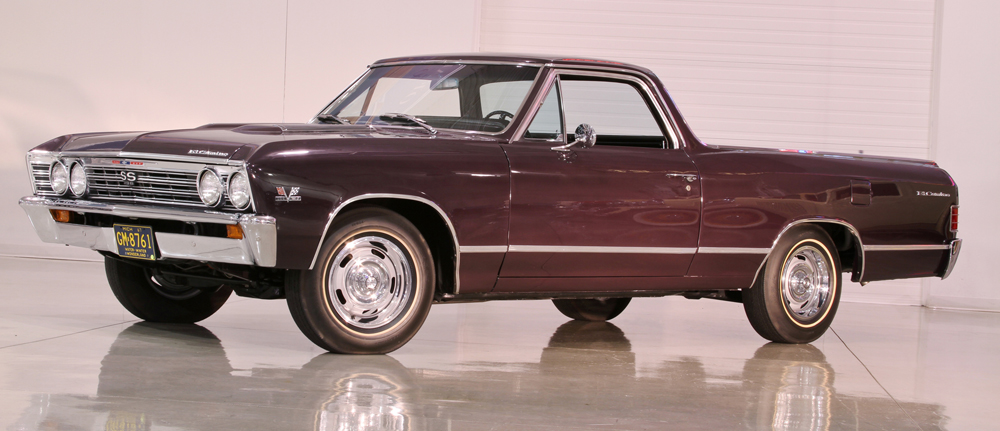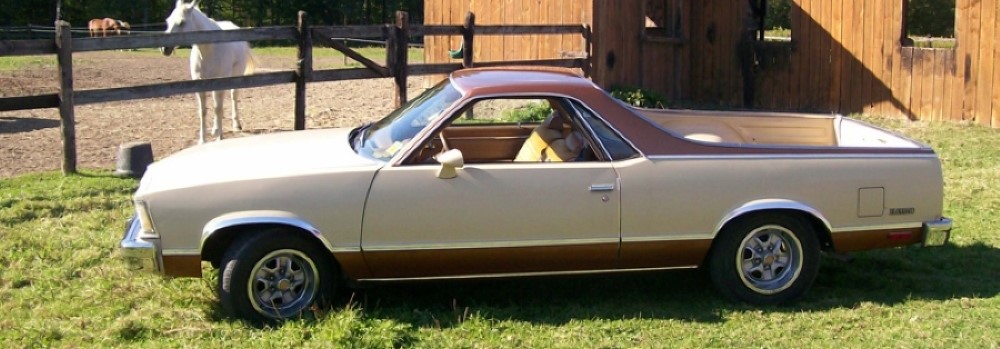
The Chevrolet El Camino
The Chevrolet El Camino is a classic vehicle that blends the characteristics of a car and a pickup truck, often referred to as a “car-truck” or a “coupe utility.” It was produced by Chevrolet from 1959 to 1960 and then again from 1964 to 1987.
- (1959–1960) First generation
- (1964–1967) Second generation
- (1968–1972) Third generation
- (1973–1977) Fourth generation
- (1978–1987) Fifth generation
1959 Chevrolet El Camino
Perhaps it was only coincidence that in the year tail fins were at their flashiest, the eminently practical El Camino first appeared. There had been car-pickup hybrids before, but none so appealing as the 1959 model, with its airy, hardtop-like roof and curving tailfins. Customizers and hot-rodders loved the El Camino from the start, and El Caminos still have a passionate following today.
Look for: Turn-signals above quad headlights. Full-length bright body-side moldings with accent paint fill. Wing-like curved rear fins and ‘cat’s eye’ taillights.

First Generation (1959-1960)
- Based on the Chevrolet Brookwood two-door station wagon.
- Offered with various engines, including a 283 cubic inch (4.6L) V8.
- Unique styling with tail fins and a wraparound windshield.
- This was the year of the completely redesigned, longer, lower and wider full-sized Chevrolet.
The El Camino was introduced for the 1959 model year two years after the Ford Ranchero. Chevrolet stylists had considered a new coupe pickup well before the Ranchero appeared; according to stylist Chuck Jordan, Harley Earl himself had suggested such a thing back in 1952.
1959 El Camino, Like the Ranchero, it was based on an existing and modified platform, namely the new-for-1959 Brookwood two-door station wagon and corresponding sedan delivery variant; unlike those models, the El Camino was available any drivetrain option corresponding to the car line, but used a single trim level; the exterior used Bel-Air trim while the inside was trimmed like a low-end Biscayne. No other trim options were available from the factory. The El Camino was built on 1959 passenger-car chassis that featured a “Safety-Girder” X-frame design and full-coil suspension, both of which had debuted on the 1958s. The 119-inch wheel-base was 1.5 inches longer than that of the 1958 models, though. Overall length for all 1959 Chevys was up to 210.9 inches (5,360 mm). The El Camino’s payload rating ranged from 650 pounds to 1150 pounds, with gross vehicle weights ranging from 4400 to 4900 pounds, depending on powertrain and suspension options specified. The somewhat soft, passenger-car-type standard suspension enabled the El Camino to stand level without a load. The 1959 El Camino was promoted as the first Chevrolet pickup built with a steel bed floor instead of wood. The floor was a corrugated sheetmetal insert, secured with 26 recessed bolts. Concealed beneath it was the floor pan from the Brookwood two-door wagon, complete with foot wells. Box capacity was almost 33 cubic feet.
The 283-cid Turbo-jet V8 with two- or four-barrel carburetion and several Turbo-Thrust 348-cid V8s with four-barrel or triple two-barrel carbs (the latter with up to 335 bhp (250 kW; 340 PS) by mid 1959) were among the entries. Even the 250- and 290-bhp 283-cube Ramjet Fuel Injection engines were available.
A total of 22,246 El Caminos were produced for 1959. That bested the count of 21,706 first-year Rancheros made in 1957 and the 14,169 Ford sedan pickups built in direct competition for the 1959 model year.


Second Generation (1964-1967)
- Shifted to the new Chevelle platform.
- More streamlined and less ornate design.
- Available with a range of engines, from an inline-six to the powerful 396 cubic inch (6.5L) V8.
1960 El Camino model started at $2366 for the six-cylinder model; another $107 for a V8 with the two-barrel 283. The base 283-cid V8 was detuned a bit for fuel economy and was now rated at 170 bhp (127 kW; 172 PS), and the fuel-injected engines were officially gone. Just 14,163 sold at which point Chevrolet discontinued the model.

1967 Chevrolet El Camino SS
The second generation (1964–1967) El Camino’s were based on the Chevrolet Chevelle. The 1964 model was similar to the Chevelle forward of the B-pillars and carried both “Chevelle” and “El Camino” badges, but Chevrolet marketed the vehicle as a utility model and Chevelle’s most powerful engines were not available. Initial engine offerings included six-cylinder engines of 194 and 230 cubic inches with horsepower ratings of 120 and 155, respectively. The standard V8 was a 283 cubic-inch Chevy small block with two-barrel carburetor and 195 horsepower (145 kW) with optional engines including a 220-horsepower 283 with four-barrel carburetor and dual exhausts. Added to the El Camino’s option list during the course of the 1964 model year were two versions of the 327 cubic-inch small block V8 rated at 250 and 300 horsepower (220 kW) — the latter featuring a higher compression ratio of 10.5:1, larger four-barrel carburetor and dual exhausts.
The 1965 El Camino received the same attractive facelift as the ’65 Chevelle, with a more pronounced V-shaped front end, and a higher performance version of the 327 engine rated at 350 hp (261 kW) that was also available in Chevelles under option code L-79 was made available. Most of the other engines were carried over from 1964, including the 194 and 230 cubic-inch Turbo Thrift sixes, the 195-horsepower 283 cubic-inch Turbo-Fire V8 and 327 cubic-inch Turbo-Fire V8s of 250 and 300 horsepower (220 kW).
In 1966, GM added a 396 cu in (6.5 L) V8 engine to the lineup rated from 325 to 375 hp (280 kW). The 1965 327 would run low 15s in the 1/4 mile (at some 90 mph), while 1966 to 1969 models were easily into the mid- to upper-14s. New sheetmetal highlighted the 1966 El Camino, identical to the Chevelle forward of the B-pillars. A new instrument panel with horizontal sweep speedometer was featured. Inside, the standard version featured a bench seat interior and rubber floor mat from the lower-line Chevelle 300 series, while the Custom used a more upscale interior from the Chevelle Malibu with plusher cloth-and-vinyl or all-vinyl bench seats and deep twist carpeting, or optional Strato swivel bucket seats with console. A tachometer was optional.
The 1967 El Camino followed the Chevelle’s styling facelift with a new grille, front bumper, and trim. Air shocks remained standard equipment on the El Camino, allowing the driver to compensate for a load. The year 1967 also brought the collapsible steering column and options of disc brakes and Turbo Hydramatic 400 3-speed automatic transmission. It was the second year the 396 could be had in the El Camino (both 13480 300 Deluxe base and 13680 Malibu series). Since the L35 396/325 hp engine was the base for the SS396 series, the number of L35 engines reported sold by Chevrolet in 1967 (2,565) were sold in one of the two El Camino series since these were the only series the engine could be ordered in. Since the L34 (now 350 hp) & L78 (375 hp) were available in either El Camino series as well as the two SS396 body styles, there is no way of knowing how many of these optional engines went to which body style. Chevrolet does report 17,176 L34 and 612 L78 engine options were sold in 1967 Chevelles, but there is no breakdown of body styles. The TH400 3-speed automatic was now available as an option (RPO M40) with the 396 engine in both the SS396 series and the 396-equipped El Caminos. The 3-speed manual transmission remained the standard transmission with a heavy duty (RPO M13) also available along with the 2-speed Powerglide and either M20 wide ratio or M21 close ratio 4-speed transmissions.

Third Generation (1968-1972)
- Updated body with more pronounced curves and a wider stance.
- Introduced the Super Sport (SS) model, featuring high-performance engines and sporty styling.
- Became more popular as a muscle car variant.
1970 Chevrolet El Camino SS
- Based on the midsize Chevy Chevelle – and fully sharing in that car line’s multitudinous power options – the 1970 El Camino SS pickup combined pickup utility with muscle car looks and power
The El Camino “passenger-car pickup” first appeared in 1959 and was, along with the ’60 edition, based on the full-size Chevy. Following a three-year hiatus, the El Camino returned for 1964, as a derivative of the new intermediate-sized 1964 Chevelle. The restyled ’68 El Camino was as sleek as any vehicle with a pickup bed could be. That same year, the El Camino was finally available with Super Sport equipment, and buyers could fully partake of the additional muscle-car options offered for the Chevelle SS. The 1970 El Camino SS, stuffed with 396- or 454-cid Chevy big-block power, is the ultimate El Camino of the muscle car era.
Fourth Generation (1973-1977)
-
- Redesigned with a larger, more boxy appearance.
- Focused more on comfort and luxury features.
- Continued to offer powerful engine options, including the 454 cubic inch (7.4L) V8.
Fifth Generation (1978-1987)
-
- Smaller and lighter due to the downsizing trend of the late 1970s.
- Featured a more aerodynamic design.
- Ended production in 1987, marking the end of an era for car-trucks in the U.S. market.


The GMC Sprint was produced by GMC for the 1971–1977 model years. The Sprint was renamed Caballero for the 1978 model year, and produced through 1987. The rear-wheel-drive car-based pickups were sold by GMC Truck dealers primarily in the United States and Canada as the GMC version of the Chevrolet El Camino.

You must be logged in to post a comment.